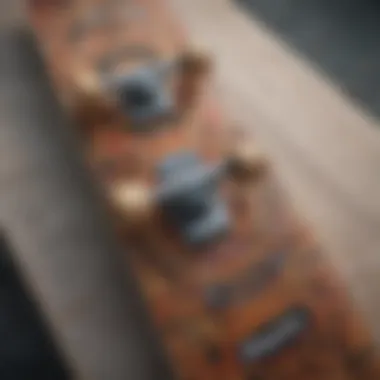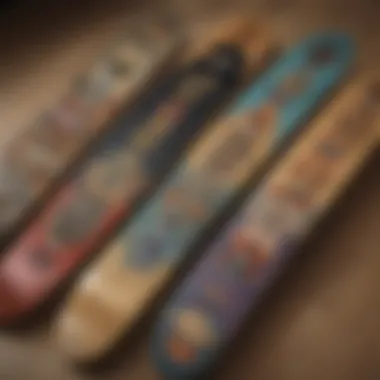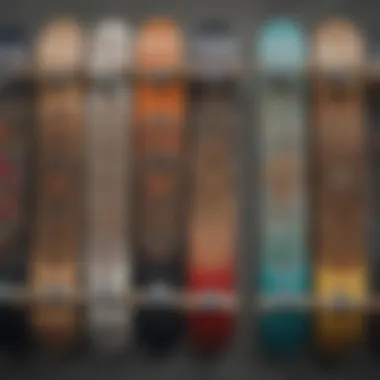Exploring Skateboard Deck Graphics: Culture and Artistry


Intro
Skateboard deck graphics are more than just flashy designs splashed across the wood; they breathe life into the culture of skateboarding, embodying the rebellious spirit and vibrant creativity of its community. As one glides down the street, the art on the deck speaks volumes about identity, style, and the journey of the rider. These graphics have evolved through the decades, mirroring societal shifts and the underground evolution of skate culture itself. From the bold and outrageous to the subtle and refined, skateboard graphics have become a language of their own.
Throughout this article, we will explore the intricate journey of skateboard deck designs, investigating how they reflect the artist’s perspective and the collective spirit of the skating community. By examining the transformation of skateboard graphics over the years, we’ll not only uncover their historical significance but also their role as contemporary artistic statements. Let's embark on this colorful journey to understand better the impact and artistry that skateboard deck graphics hold in the skateboarding world.
Prelude to Skateboard Deck Graphics
Skateboard deck graphics aren't just a visual accessory; they are a vibrant mode of communication that resonates through the culture. As skaters glide on their boards, each design tells a story, whispers a trend, or reflects a community's ethos. These artistic expressions play a pivotal role in building identity among skateboarders, transforming plain wooden decks into dynamic canvases that capture attention and spark conversations.
Definition and Importance
At its core, skateboard deck graphics refer to the designs printed on the top or bottom of a skateboard. These visuals range from complex illustrations to bold typography, embodying unique styles that resonate with skaters’ personalities and ideals. Why does this matter? Because skateboard graphics are not merely decorative; they encapsulate the very identity of the rider. They create connections within the skateboarding community, acting as symbols of attitudes, affiliations, and artistic talents.
The importance of these graphics can't be overstated. For new skaters, a well-chosen deck can serve as a badge of honor, aligning them with certain subcultures or ideologies. Seasoned skateboarders often select decks that reflect their journey, using them as a means to express nostalgia or a radical rebirth in their skating journey. Each graphic is a statement, an intricate ballet of colors and shapes that can reflect everything from local culture to global trends.
Historical Context
To truly appreciate the art of skateboard deck graphics, one must look back at how it all began. Skateboarding emerged in the late 1940s and early 1950s as surfers in California sought to mimic the waves on land. However, it wasn’t until the 1970s that skateboard designs began to gain prominence. During this period, graphics began to evolve, moving away from plain designs to more intricate art influenced by punk rock and graffiti culture.
As skateboarding grew popular through the 1980s, skate deck graphics became a canvas for artistic expression. Iconic designs from companies like Powell Peralta and Santa Cruz inspired a new breed of artists who took to creating visually striking images filled with whimsy and rebellion. This era marked the dawn of graphics that were not just about a logo; they became works of art.
Fast forward to the present day, and skateboard graphics have not only persisted but evolved into a significant industry within skate culture. Contemporary artists blend various influences, from street art to digital design, making each deck a unique masterpiece. Today, skaters can choose from an array of styles that cater to personal tastes and cultural narratives, making deck graphics an integral aspect of skating and a powerful means of artistic expression.
Evolution of Skateboard Deck Graphics
The evolution of skateboard deck graphics serves as a crucial lens through which to understand the broader landscape of skate culture. As the art form has developed over time, so too have the messages and cultural commentary that it carries. Skateboard graphics have transitioned from simple designs, rooted in functionality, into multi-faceted expressions of individuality, community, and social issues. Not only do these graphics reflect the stylistic preferences of different eras, but they also embody the shifting attitudes and identities of skateboarders themselves.
The Early Days of Skate Graphics
In the nascent days of skateboarding, particularly during the 1970s, graphics on decks were quite minimalistic. Often, they consisted of a company logo or a single-colored design. Skateboards were not considered "art" but rather practical equipment. The focus was primarily on performance, not aesthetics. As skateboarding began gaining traction, the graphics started reflecting the lifestyle and the burgeoning youth culture. Decks from those early years can be characterized by vibrant colors and simple geometric shapes, hinting at influences from surf culture, given that many early skateboarders had roots in surfing.
1980s and the Explosion of Color
The 1980s marked a definitive turning point in skateboard deck graphics. The combination of the punk rock movement and burgeoning street art led to an explosion of color and creativity. Bright, dynamic designs flooded the market, pulling inspiration from various sources, including comics, graffiti, and even pop art. Artists like Jim Phillips and the infamous Santa Cruz Skateboards collaborated with skaters to create decks that were not just functional, but also visually captivating.
The introduction of specialized decks for different styles of skating increased diversity within the market. Each board became a canvas for self-expression, allowing riders to showcase their personalities. Graphics ranged from wild and chaotic to sleek and minimalistic, mirroring the wide array of skating styles that were evolving during this period.
1990s Trends and Iconography
The 1990s ushered in a level of sophistication in skateboard art that had far-reaching implications. Graphic design became increasingly influenced by popular culture, tapping into themes from music videos, films, and emerging technology. This era saw the rise of signature models—decks designed specifically for individual pro skaters, which further personalized skate graphics. Iconic designs from brands like Girl Skateboards and Alien Workshop began to influence the whole industry, establishing a kind of visual language recognizable to those within the culture.
Not only did graphics continue to push the envelope, but they also began to challenge conventional norms. Designs that once were playful or abstract now delved into more controversial territory, addressing social issues like race and inequality. Skaters used their decks as platforms for commentary, reshaping the narrative around what graffiti and art could express.
Contemporary Trends and Innovations
In recent years, skateboard deck graphics have continued to evolve, fueled by advancements in technology and a more interconnected global community. Digital design has allowed artists to play with new techniques and styles that were once impossible. Skate brands such as Palace and Baker have embraced a blend of irony, nostalgia, and edgy humor that resonates deeply with a younger audience.
Eco-awareness also makes its footprint here, as some brands take conscious steps towards sustainability, offering designs printed with plant-based inks on recycled materials. Moreover, collaborations with established artists and other creative industries have pushed the existing boundaries even further, creating a cross-pollination of ideas and influences.
In essence, skateboard deck graphics now reflect not only aesthetic desires but also ethical considerations, making them a fascinating study of where art intersects with culture and identity.
"Skateboard graphics have transformed from mere decoration to potent statements of identity and community values."


Through understanding the evolution of these graphics, it becomes evident that they are much more than just a pretty face; they are a commentary on changing societal norms and an articulation of the voices within the skate community.
Artistic Styles in Skateboard Graphics
Artistic styles in skateboard graphics serve as a lens through which enthusiasts and outsiders can understand the deeper narratives behind skate culture. These styles not only showcase the creativity and individuality of artists but also reflect the diverse backgrounds and experiences of skaters. The importance of this topic lies in its ability to bridge art and identity, making graphics a critical component of a skateboarder’s expression and community connection.
Psychedelic Art Influences
Psychedelic art, with its bold colors and swirling patterns, has made a notable impact on skateboard deck graphics. Originating from the countercultural movements of the 1960s, this style appeals to the alternative spirit of skateboarding—a scene often rooted in rebellion and self-exploration. Designers draw inspiration from artists like Peter Max and the vibrant visuals of classic rock concert posters.
Skateboards featuring psychedelic influences often incorporate motifs that seem to flow and shift, mirroring the dynamic movements of skating itself. This type of artwork doesn’t just look good; it resonates. When a skater rolls down the street on a deck adorned with a vivid, mind-bending design, it tells a story that goes beyond the surface. It creates an immediate connection with viewers, evoking emotions and conveying a message of freedom.
Minimalism and Typography
If the psychedelic style flourishes in exuberance, minimalism beckons with simplicity. The trend of minimalism in skateboard graphics strips down unnecessary embellishments, focusing instead on clean lines, limited color palettes, and straightforward messages. Typography often plays a significant role here. The words can be meaningful slogans or simple expressions that encapsulate the beliefs or attitudes of skate culture.
Designers prioritize form and function; every letter and line serves a purpose. This style speaks to the essence of skateboarding, promoting clarity and directness. When you see a board featuring a stark black-and-white design with bold type, it hits home harder than any intricate design. It speaks to the skater's personality without the need for overstatement.
Pop Culture and Graphic Novel Inspirations
The infusion of pop culture and graphic novel art into skateboard graphics has brought forth a whole new world of creativity. Artists often pay homage to classic comics, anime, and even contemporary media. This style creates a hybrid visual narrative that captures the youthful spirit and audacity of skateboarding.
Much like comic book panels, skateboard graphics can tell a story or encapsulate a moment of action, drawing skaters into a fantastical realm while they ride. Every character depicted, from masked superheroes to quirky caricatures, can resonate with a skater’s personality. It not only serves as a decorative piece but also acts as a conversation starter within the community, as everyone may interpret the imagery differently.
Street Art and Graffiti Styles
Street art and graffiti have long found a home in skateboard culture, as both forms are born from urban environments and share a common language of rebellion and expression. Decks adorned with graffiti styles reflect the gritty reality of city life and often depict social messages or political statements. This style embodies the raw energy of skaters who embrace the anarchic freedom of expressing themselves in the streets.
Influential street artists like Banksy or Shepard Fairey inspire skateboard designs, weaving narratives that challenge societal norms. Each skateboard deck turns into a canvas, showcasing messages that resonate deeply with both skaters and the broader public. This connection helps elevate the skateboard from mere footwear to a statement piece brimming with cultural significance.
Skateboard graphics are not just decoration; they hold the power of identity and belonging, resonating with skater communities across the globe.
In the realm of skateboarding, different artistic styles capture the multifaceted experiences of skaters while nurturing a sense of identity and belonging within the community. As each design tells a story, emotional connections deepen, proving that skateboard deck graphics are indeed a vital part of skate culture.
Cultural Significance of Graphics
Skateboard deck graphics carry a weight that extends far beyond mere aesthetics; they encapsulate the very essence of skate culture. These visuals act as a powerful medium for personal and collective expression. The way a skateboarder chooses their deck can often speak volumes about who they are, what they value, and the wider community to which they belong.
Identity and Personal Expression
Each skateboard deck is like a canvas, reflecting the individuality of its rider. Choosing a deck that showcases certain imagery can signal affinities towards specific styles, ideologies, or eras in skate history. For instance, a rider who opts for a deck adorned with bold, psychedelic art may be signaling a connection to the vibrant, rebellious spirit of the 1960s and 70s. In contrast, those selecting minimalist designs might align themselves with the modern trend of simplicity and elegance in design.
Through graphics, skateboarders not only express their own identities but also their personal stories. The imagery can encompass everything from deep cultural symbols to favorite bands, fashion trends, or personal philosophies. Each graphic acts as a talking point within the community. A skateboarder wielding a stark black deck with an intricate line design often invites curiosity and dialogue, while a brightly colored deck featuring famous cartoon characters might evoke nostalgia and bring a smile.
Graphics as a Reflection of Subculture
Skateboarding is more than a sport; it’s a lifestyle intertwined with a myriad of subcultures. The graphics on decks serve as a visual representation of these influences. From punk rock to hip-hop, the cultural connotations embedded in deck designs reflect the ever-evolving landscape of society. For example, during the 1990s, the proliferation of graffiti art not only adorned urban landscapes but also found its way into skateboard decks, elevating the street art scene and merging two thriving subcultures.
Moreover, skate graphics often serve as a medium for social commentary, raising awareness about issues like environmentalism, anti-establishment sentiments, or social injustices through artful designs. Thus, a skateboard deck becomes a mobile canvas, allowing skaters to carry their beliefs and affiliations wherever they roam.
Commercialization vs. Authenticity
The commercialization of skateboard graphics has sparked a dynamic tension between mass production and grassroots authenticity. While many companies have stepped into the skateboard arena, producing decks that are visually impressive, there's always a segment of the community that yearns for the uniqueness of independent artists. These riders often appreciate limited runs or hand-painted designs that speak to their individuality and a deeper connection to the culture.
As skateboard decks have garnered more attention from the mainstream market, issues surrounding authenticity arise. Some community members argue that the commercialization dilutes the essence of what skateboard graphics originally represented—raw creativity and expression born from subcultures. In this light, numerous independent artists have emerged, challenging big brands and advocating for authentic, original designs that resonate with true skate culture.


"Skateboard decks are not just tools for riding; they are a platform for self-expression, cultural commentary, and a testament to where you stand within the skate community."
Notable Skateboard Artists
When it comes to the world of skateboard deck graphics, a handful of artists stand out like bright-colored stickers on a plain wall. These individuals are not just painters; they are visionaries who have shaped the landscape of skate culture through their unique styles and artistic contributions. Recognizing their impact is essential for understanding how skateboard graphics have evolved and how they continue to influence skaters around the globe.
Influential Figures in the Industry
Throughout history, certain figures have emerged as pioneers in the skateboard art realm. One cannot overlook the work of Jim Phillips. Famous for his creation of the iconic screaming hand logo for Santa Cruz Skateboards, his graphics define the energy and attitude of the 1980s skate culture. Similarly, Ed Templeton, a pro skater turned artist, infused his personal experiences and sociopolitical commentary into his work. His illustrations reflect a narrative style that resonates deeply with skateboard enthusiasts.
Another noteworthy artist, Todd Francis, is renowned for blending humor and strong visuals, seamlessly integrating social commentary into his graphics. His work brings attention to various issues, prompting conversation beyond the skateboard scene itself. These artists, among many others, have played a crucial role in elevating skateboard deck graphics to a recognized form of artistic expression. The influence of their work stretches beyond mere decoration; it serves as a powerful reflection of the lifestyle and values inherent in skateboarding.
Emerging Artists and Their Impact
While established artists have set the stage, emerging talents are continually pushing the boundaries of skateboard graphics. Many of these newer artists come from diverse backgrounds, infusing fresh perspectives and styles into their work. For instance, artists like J. Grant Brittain, who blends photography with graphic design, capture the essence of skate culture in a way that resonates with today's youth.
Younger artists are also integrating tech into their designs; digital art allows for experimentation that wasn't possible in previous decades. They leverage social media platforms to share their creations. An Instagram artist might showcase their deck graphic design just as easily as any professional, gaining a following almost overnight.
"The characteristic of true art is that it should never go out of style. The artwork on a skateboard deck tells a story, not just of the board but of the community and culture behind it."
As skateboarding continues to grow—both as a sport and a community—these emerging artists play an essential role in representing the evolving identity of skaters. They tackle contemporary issues through their art, whether it’s social justice, mental health, or environmental consciousness, and reflect the values of a new generation of skaters. Their presence signifies a shift, enriching the community and ensuring that skateboard deck graphics remain relevant and impactful.
The Design Process of Skateboard Graphics
The design process of skateboard graphics is a pivotal component of not just art creation, but also of establishing an identity within the skateboarding community. It goes beyond mere visual aesthetics; it encompasses concept development, artistic choices, and practical considerations that collectively form the essence of a skateboard deck's identity. With every graphic, there’s a story or a statement, creating a connection between the skater and their board. It’s an intricate dance between the artist’s vision and the practicalities of manufacturing, blending artistry with functionality.
From Concept to Production
Crafting a skateboard deck graphic begins with a spark of creativity, often driven by personal experiences or cultural commentary. Artists may sketch out several concepts, drawing from diverse influences such as graffiti, pop culture, or even their own emotions. This brainstorming phase is critical, as it sets the tone for the entire project. Feedback is crucial during this phase, allowing artists to refine their ideas based on input from peers or potential consumers.
Once a concept is better defined, the artist tends to create detailed sketches, often exploring various color palettes and design elements. This helps in visualizing how the final product will look on a board.
From there, the selected designs are translated into digital form using graphic design software like Adobe Illustrator or Procreate. Digital tools provide artists with the flexibility to manipulate colors, shapes, and refine details. After final approval, the design moves onto the production phase. At this stage, the design is printed onto a vinyl sticker or directly on the deck itself, utilizing techniques such as silk screening or heat transfer.
Material Choices and Techniques
When it comes to materials, skateboard graphics are typically printed on a variety of surfaces, depending on the desired look and feel. Common choices include:
- Wood: This is the traditional canvas, offering a natural aesthetic and solid durability.
- Vinyl: Often used for graphics printed as stickers, it provides flexibility and ease of application.
- Specialty Finishes: Some decks may use finishes like matte or gloss to enhance the visual impact of the graphic.
In terms of technique, different printing methods can yield vastly different end results. For instance:
- Silk Screen Printing: This method produces vibrant colors and is ideal for designs that require solid, bold lines. It’s slightly more labor-intensive but affords excellent quality.
- Digital Printing: Offers the possibility of intricate designs and gradients, allowing for more complexity in graphics.
- Pad Printing: Useful for multi-surface applications, ensuring high-definition graphics can be applied smoothly on curved surfaces.
As skateboard graphics continue to evolve, understanding these materials and techniques helps balance artistry with durability, ensuring that what looks good also withstands the rigors of use. The journey from concept to completion is not just about visuals; it's a reflection of culture, identity, and an artistic medium in its own right.
Community Engagement and Deck Graphics
Community engagement serves as a vital thread connecting skateboard deck graphics with the broader skateboarding culture. Skaters aren’t just consumers; they are also creators and collaborators. Their engagement goes beyond just the act of skating, often morphing into a platform where artistic expression and social causes intersect. The act of customizing a skateboard deck is not merely an aesthetic choice; it’s a resonant statement about personal identity and community values.
A key element in this engagement is how graphics reflect local culture. Artists often draw inspiration from their environment, transforming community narratives into visual art. These graphics become a canvas for highlighting issues ranging from social justice to environmentalism. For instance, a deck graphic might* spotlight local history or poignant social issues*, sparking dialogue amongst skaters about their community and its challenges.
Grassroots Initiatives and Collaborations


Grassroots initiatives in skateboard graphics have been gaining momentum, and for good reason. Small, community-Based projects facilitate collaborations between local artists and skateboarders, paving a path for innovative designs that resonate with regional culture. These initiatives often center around local events, where the community comes together to celebrate skate culture while promoting local art.
For example, consider an event organized at a community skate park. Local artists can showcase their works, while skaters are encouraged to decorate their decks live. This not only fosters artistry but also promotes a sense of belonging within the skate community.
Moreover, successful collaborations can transcend the skateboarding scene, uniting skaters and non-skaters alike. Here are some notable benefits of these grassroots collaborations:
- Promotion of Local Talent: Emerging artists gain visibility and recognition, expanding their audience.
- Strengthening Community Identity: Art becomes a source of pride, reinforcing local identity.
- Creating Safe Spaces: Skate parks that showcase local art can foster community connections and deter vandalism.
Skate Parks and Their Role in Art
Skate parks are more than just concrete structures; they are cultural hubs where art and community converge. The role of skate parks in promoting deck graphics is profound. These spaces act as exhibition grounds where skateboarders display their personal touches through their choice of graphics, turning the act of skating into a vibrant art form.
Moreover, skate parks often become the stage for larger creative endeavors, including murals and installations that transform the park's atmosphere. Artists are frequently invited to paint walls, paving the way for temporary or permanent installations that can serve as backdrops for skateboarding tricks. Some parks even hold contests that allow skaters to design a limited edition series of decks, with winning designs being manufactured and sold.
Each graphic tells a story, reflecting the unique fabric of the community it comes from.
In summary, the fusion of community engagement and skateboard deck graphics reveals a rich tapestry of artistic expression within skate culture. Through grassroots initiatives and the animated environment of skate parks, skaters can forge connections between artistry and identity, crafting a narrative that resonates deeply within their communities.
The Future of Skateboard Deck Graphics
The landscape of skateboard deck graphics is at a crossroads, where tradition meets innovation. As we look ahead, we see a profound transformation that hints at exciting possibilities. The continued evolution of art on skateboards is not just about aesthetic appeal. It also reflects broader themes in technology, culture, and community. In this section, we will explore key elements that are shaping the future of skateboard deck graphics, particularly focusing on technological advancements and sustainable practices.
Technological Advancements in Design
Advancements in technology have drastically reshaped how skateboard deck graphics are designed and produced. No longer confined to paints and stencils, the modern artist can utilize a plethora of tools for creating visually stunning graphics. Digital design software such as Adobe Illustrator or Procreate allows artists to manipulate colors, patterns, and shapes with precision. Additionally, 3D printing technologies enable the creation of intricate designs that were once unthinkable.
Moreover, the introduction of augmented reality (AR) is paving new ways in how skateboard graphics are experienced. Imagine riding a skateboard that doesn't just display a design but animates it right before your eyes! This blend of reality and art has the potential to deepen the connection between skaters and their decks.
- Digital Printing: This technique allows for high-quality images that resist fading, making the artwork last longer against wear and tear.
- Interactive Designs: Some artists are exploring QR codes embedded into their graphics, leading viewers to digital content that adds another layer to the skate experience.
Not only does tech elevate artistic expression, but it also opens room for collaborations across different creative fields, pushing the envelope further.
Sustainability and Eco-Friendly Practices
As the world becomes more attuned to ecological concerns, the skateboard community is increasingly prioritizing sustainability in deck graphics. The focus is not only on how the graphics are applied but also on what materials are being used. Many brands are now opting for water-based inks that are less harmful to the environment compared to traditional solvents.
There’s a growing trend toward using recycled wood and other sustainable materials for skateboard decks. This practice not only reduces waste but also appeals to a more environmentally conscious demographic. Graphics made from biodegradable materials are emerging as well, with artists getting creative about how to blend aesthetics with eco-friendliness.
"Incorporating sustainability is not a trend; it's a responsibility. Those who design skateboards have the power to make impactful choices."
The following initiatives are examples of how the industry is embracing eco-friendly practices:
- Local Sourcing: More companies are choosing to source materials locally, thus reducing their carbon footprint.
- Upcycled Graphics: Artists are experimenting with upcycling, taking old graphics from damaged boards to create new, original pieces.
By marrying artistic innovation with sustainability, the future of skateboard deck graphics promises not just to look good, but to also contribute positively to the planet and the community. It’s a powerful moment in the skateboarding scene, where tradition harmonizes with forward-thinking ideals.
Culmination
The journey through the vibrant world of skateboard deck graphics highlights its critical role in shaping the culture around skateboarding. These graphics go beyond mere decoration; they serve as symbols of identity, creativity, and a direct line to the communal experience of the skateboarder. It’s vital to recognize how these illustrations not only reflect the personal style of each skater but also act as a commentary on broader social themes.
Final Thoughts on Graphics in Skate Culture
In today’s scene, skateboard graphics are more than just pops of color or eye-catching designs. They encapsulate the essence of a generation and carry stories, messages, and emotions that resonate with both the individual and the collective.
- Identity and Expression: The graphics become an extension of the skater's personality. Whether opting for the audacious designs of the 80s or the sleek minimalism seen today, each graphic tells a unique story.
- Cultural Commentary: The art on skateboards often addresses societal issues, political movements, or trends that shape our world. Skaters use their decks as canvases to express dissent, support, love, or humor around current events.
- Innovative Designs: The advent of advanced printing technologies and sustainable materials has opened new doors. Designers are experimenting with techniques, blending traditional art forms with new-age digital flair.
As we look to the future of skateboard deck graphics, one cannot overlook the interconnectedness of art, culture, and sport. It urges us to reflect on how external influences shape what we see on skateboards today. The future will demand not just more colors but greater depth, more thoughtful designs infused with sustainability and a sense of community. Graphic design in skateboarding is, indeed, a microcosm of the larger cultural narrative, bound to keep evolving as long as there's someone ready to ride.
"Skateboard decks are more than wood and wheels; they are a rolling canvas, telling stories and igniting revolutions."
Through exploring skateboard graphics, one gains insight into an art form that is alive, dynamic, and deeply threaded into the fabric of modern skate culture. Understanding this, it's easier to appreciate that, at the end of the day, each graphic is not just an image but a piece of a wider dialogue within a community that thrives on creativity, rebellion, and unity.



